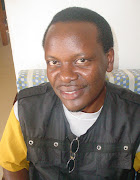 Ebenezer T. Bifubyeka (Ten),
Ebenezer T. Bifubyeka (Ten),Biafra, Mbarara, western Uganda.
LET’S stop depending on God and use scientific ways of conserving nature and harvesting water. Most people only pray to God to avert the looming water crisis in five districts in south-western Uganda. The emerging water crisis follows the dropping water level of River Rwizi over environmental degradation and climate change.
If it doesn’t rain soon, water pipes at both Mbarara water supply plants will have no water to pump from River Rwizi, the main source of water in Mbarara, Bushenyi, Ntungamo, Isingiro and Kiruhuura districts! Rwizi is also a tributary of Lake Victoria.
Within less than two months, from April to mid June 2009, River Rwizi dried up by close to one metre, according to the water quality control officer for National Water and Sewerage Cooperation, Christopher Kanyesigye!
Dropping water level in River Rwizi has already constrained water supply. Residents of Katojo-Ngara and Nyakayojo have not received water for sometime; besides water rationing in Mbarara municipality!
Let’s dike (creating dams) the water along River Rwizi and reserve it for use during dry seasons like this, as suggested by the founder and executive director of forum of climate change, MP Charles Ngabirano. Indeed, the recent eastern floods cleared and left people waterless. That water should have been harvested in dikes.
The dirtiness or turbidity of River Rwizi over silt has increased from 30 units to 110 in this dry spell! The colours of River Rwizi have also increased from 60 units of water-quality parameter to 300 in this season! The best colour unit level is five.
This has increased the cost of treating water to the normal unit level of five to three units, which is safe for pubic consumption. Water beyond the turbidity level of 15 units is not recommended by experts for domestic use.
Human activities like agriculture carried out in 30 sub-counties along the shores of River Rwizi – leave a lot of silt on the river basin (sedimentation).
The 1995 National Environment Act, Cap. 153 says, River Rwizi is a regulated river with a protection zone of 100 metres – for natural regeneration interventions like wetland restoration and tree planting, according to the national environmental management authority’s western regional public awareness officer, Jeconious Musingwire.
Even distant water catchment areas for River Rwizi like wetlands have been encroached on in Buhweju and Rwampara hills, as per communication from the Western Uganda site manager for the wetlands sector strategic plan-support project in the ministry of water and environment, Bernard M. Arinaitwe.
Residents have encroached on the water channels in Ntare, Ndaija, Nakivale, Ntungamo and Buhanama in Itojo. Brink-laying is done in wetlands in Ruti near Mbarara town. The soil is opened, water dries and floods wash away the open soil to River Rwizi!
The ‘I-don’t-care-attitude’ elucidates imminent doom! Look at the swamp at Busega at the main gate of Kampala city from Mbarara. It’s being reclaimed openly! Who seems to bother? Are the bylaws and national environmental act meant for drawers?
However, many people blame the lowering of water levels in River Rwizi on the farmers’ poor farming methods and deforestation. But scientists peg the main cause of worldwide water crisis to climate change – a consequence of green house gas emissions that warm the world (global warming).
The Environment Atlas published by National Environmental Management Authority (NEMA) says, in 1906, 43 mountains in Africa had glaciers but in 2005, only three mountains had glaciers. Worse still, the ice caps are sharply declining on Mt. Rwenzori!
Ends.
Word count: 576.


3 comments:
you look a gentleman this time round.
Thank God.
and very hardsome by the way as your workmates old u.
For sure God is great, He did his part and he returned you back of the right truck. Now you are a gentle man not like the way you was with long 6 inch hair.
Agaba Senate Baringi
Director
Senex Artists & Printers Co. Ltd.
Post a Comment